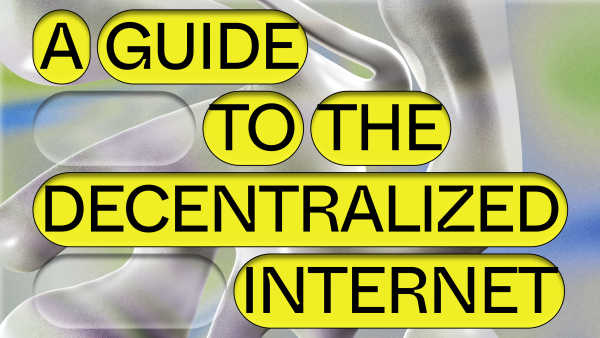What is web3?


The term web3 has been around since 2014, but it’s gained traction and near-ubiquity over the last year as a way to describe the rise of an internet (and networks, and apps, and even design systems) built using decentralized blockchains. More than a buzzword, it’s a vision for a better internet; powered by transparency, openness, and creativity. And it’s a key framework for thinking about the web we build next: one that will have a profound impact on creators, publishers, and IP.
Web3 is the decentralized internet.
If you’re reading this, you’ve probably heard about blockchain technology. (^_−)☆ A blockchain is a distributed database that allows for secure, transparent, and tamper-proof transactions. While blockchains were originally developed to support cryptocurrency, they are now being used for a wide range of applications, from supply chain management to identity verification.
And that’s where web3 comes in. Web3 is the decentralized internet: spanning decentralized money (cryptocurrencies like Ethereum and Bitcoin), decentralized identity (wallets like Metamask that give you access to your accounts, sites, and data settings), decentralized storage (distributed file storage systems like IPFS and Arweave); new types of digital assets (like NFTs) and new marketplaces (like Opensea).
These diverse applications are all built using blockchain technology. Generally speaking, this provides users with greater control over their data, and makes it more difficult for bad actors in exploit vulnerabilities. Critically, this also generates new opportunities to create and connect in digital spaces. Let’s dive a little deeper.
A very short, vastly simplified history of the internet.
Over at ConsenSys, James Beck describes the evolution of the internet as the shift from read-only to read-write-own. Web1 was built on open source protocols like TCP/IP, SMTP, and HTTP. These protocols dictate the flow of information online. Because they’re open source, you can build an application or service on them, without having to pay for access.
A web1 site is one that (imagine this) you only read. The Space Jam site (1996) is a beautiful and perfectly preserved example from this era, and, as much as I love it: I can’t leave a comment on there. Web2 ushered in the next phase of the internet, as closed platforms building on top of the internet’s original open source protocols enabled users to bring their own content online. From microblogging to Meta: sites became read-write. But there’s a trade-off: in exchange for content hosting and access, Web2 platforms collect, centralize, and control user data. You’re the product.
Web3 represents a new model. Like web1, it’s based on open source protocols. Like web2, individual users can create and contribute to platforms. However, there’s a key difference. Builders, creators, and users own a piece of the web3 platform they’re participating in. Blockchains like Ethereum have provided an early example of how this can work, rewarding users with ETH for updating the ledger or securing the network. Networks built on smart-contract blockchains have also introduced new models for ownership. Tokens can grant shares, but also participation in governance, access to exclusive experiences, reward for service, and more.
As a creator or a brand thinking about entering this space, this is about navigating a new medium: one that you shape and share with your community.
What are the potential benefits for creators looking to build projects on web3?
Over the course of the past year, some of the world’s biggest brands (Nike, Netflix) and largest IP (DC, Warner Bros.) have launched web3 projects. Over 100 brands are now active in the space, representing an estimated $6.38BN in revenue. At the same time, artists have established web3 as a rich substrate for creative exploration and remuneration. New genres are taking form. New subcultures are emerging. And new, more sustainable remuneration models are being tested.
For brands and creators, decentralized applications (dapps) that run on decentralized networks offer a number of potential advantages, including increased security, privacy, resilience, and censorship resistance.
NFTs, or non-fungible tokens, represent a new type of digital asset, and an expansive new art form. NFTs can be 1 of 1 works, collectibles, avatars, or access passes. They can be fixed or generative, video or static; they can be network aware, and dynamic. As a medium, NFTs present creators with a powerful toolkit for expression.
NFTs also present a new revenue stream: one that offers more creator control over pricing and distribution strategy. If your work has a physical or IRL component, NFTs can offer another storefront, and an additive, complementary experience for collectors.
But not all drops need to be paid. NFTs provide creators with a new, direct channel for community-building; one that isn’t mediated by third party platforms. You can reach your audience of collectors directly. You can offer them exclusive experiences and incentives. You can allow them to become stakeholders in your own work. You can collaborate in real time: offering fans the right to commercialize new work based on your NFT, or providing them with the right to shape the project through governance or inworld voting.
What are some of the challenges to web3 adoption?
The landscape of web3 is still emerging. We’re at the beginning of the beginning; there’s “hope, romanticism”, and a lot of optimism about the potential for positive cultural impact. But real challenges exist when it comes to mainstreaming adoption.
One of the biggest barriers is interoperability. Because there are so many different protocols and standards across web3, it can be difficult for different applications to communicate with each other. In turn, project discovery may present a challenge without adequate marketing.
Scalability is another issue. Because decentralized applications are built on distributed networks, they can have a hard time scaling up to meet demand. Palm network was built to help solve for this issue: using IBFT 2.0 proof of authority (PoA) consensus to enable energy efficiency, transaction speed, and delivery at scale.
Among non-technical barriers, education is key. Dapps can feel technical for new users, and require new user experiences: whether it’s making your first crypto purchase, or creating your first smart-contract. And with all the creative potential of NFTs comes complexity. Making content the way you’d make something for web2 won’t work. Denis Nazarov breaks it down simply: collect isn’t like. It’s a deeper, more intentional way of connecting with your audience.
How do I get started on web3?
The best way to learn is by doing. ♡ If you’ve never collected an NFT, Palm network is a great place to get started: whether you’re interested in baseball, comics, or fine art.If you’re a developer, head over to the Palm network docs page to get started building on the network.
And if you have a question, shoot us a note or hit us up in Discord. Web3 is about the world we build together: we’re here for your ideas.







